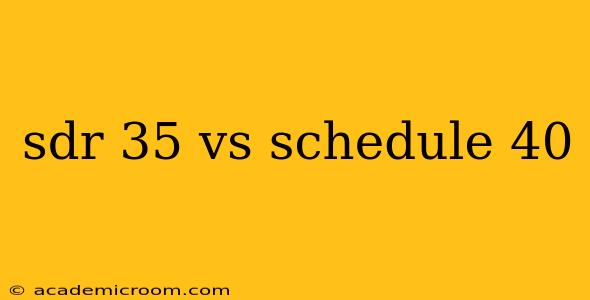SDR 35 vs. Schedule 40 Pipe: A Comprehensive Comparison
Choosing the right type of pipe for your project is crucial for ensuring its safety, longevity, and efficiency. When it comes to steel pipes, two common standards often cause confusion: SDR 35 and Schedule 40. This detailed comparison will help you understand the key differences and determine which option best suits your needs.
Understanding the Basics: SDR and Schedule
Before diving into the specifics, let's clarify the terminology. Both SDR 35 and Schedule 40 refer to the pipe's wall thickness and pressure rating.
-
SDR (Standard Dimension Ratio): SDR is a dimensionless ratio calculated by dividing the outside diameter of the pipe by its wall thickness. A lower SDR number indicates a thicker wall and higher pressure rating.
-
Schedule: Schedule is a numerical designation that also reflects the pipe's wall thickness and pressure rating. Higher schedule numbers correspond to thicker walls and higher pressure capabilities.
SDR 35 vs. Schedule 40: Key Differences
While both SDR 35 and Schedule 40 pipes are used for various applications, they differ significantly in their wall thickness and pressure ratings. Here's a breakdown:
| Feature | SDR 35 | Schedule 40 |
|---|---|---|
| Wall Thickness | Thinner | Thicker |
| Pressure Rating | Lower | Higher |
| Cost | Generally less expensive | Generally more expensive |
| Applications | Irrigation, drainage, non-pressure applications | High-pressure applications, gas lines, water distribution |
| Weight | Lighter | Heavier |
What are the advantages and disadvantages of each?
SDR 35 Advantages:
- Lower Cost: Due to its thinner wall, SDR 35 pipe is generally cheaper than Schedule 40.
- Lighter Weight: Easier to handle and transport.
- Suitable for low-pressure applications: Ideal for irrigation, drainage, and other non-pressure systems.
SDR 35 Disadvantages:
- Lower Pressure Rating: Not suitable for high-pressure applications.
- Less Durable: More susceptible to damage from external forces or pressure fluctuations.
Schedule 40 Advantages:
- Higher Pressure Rating: Capable of withstanding higher pressures, making it suitable for gas lines, water mains, and other demanding applications.
- Greater Durability: More resistant to damage and punctures.
- Longer Lifespan: Its thicker wall provides greater resistance to corrosion and wear.
Schedule 40 Disadvantages:
- Higher Cost: More expensive than SDR 35 pipe due to its thicker wall.
- Heavier Weight: More difficult to handle and transport.
- Overkill for low-pressure applications: Using Schedule 40 where SDR 35 would suffice is wasteful and unnecessary.
What are the typical applications for each?
SDR 35: Common applications include agricultural irrigation systems, drainage systems, and low-pressure industrial processes.
Schedule 40: Commonly used in high-pressure water distribution systems, natural gas lines, and industrial applications where high strength and durability are required.
What factors should I consider when choosing between SDR 35 and Schedule 40?
The choice between SDR 35 and Schedule 40 depends primarily on the intended application and the required pressure rating. Consider these factors:
- Pressure Requirements: The most crucial factor. Determine the maximum pressure the pipe will be subjected to.
- Application: What will the pipe be used for? Low-pressure irrigation? High-pressure gas transport?
- Budget: SDR 35 is generally more economical.
- Installation Considerations: Weight and handling ease are important aspects for large projects.
Are there any other pipe schedules I should know about?
Yes, there are other schedules available, such as Schedule 80 and Schedule 160, offering even greater wall thickness and pressure ratings. The higher the schedule number, the thicker the wall and the higher the pressure capability, but also the higher the cost and weight.
By carefully considering these factors and understanding the differences between SDR 35 and Schedule 40 pipes, you can make an informed decision that ensures the safety, efficiency, and longevity of your project. Remember to always consult relevant codes and standards for your specific application and location.
